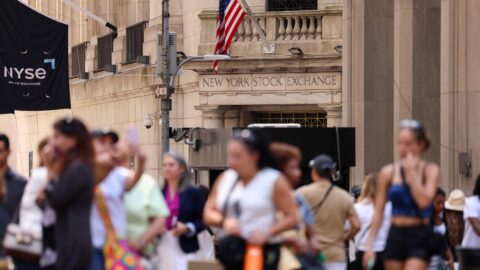The Sahm Rule caused a stir on the markets at the beginning of August. This leading economic indicator was triggered for the first time since the coronavirus pandemic. But what does this rule mean and how meaningful is it actually? In the following blog post, we address these and other questions relating to the Sahm Rule.
Simple recession indicator
The Sahm rule developed by economist Claudia Sahm serves as a simple indicator for the start of a recession in the United States. It is based on changes in the unemployment rate and provides timely insights for policy makers and analysts.
The calculation of the rule is simple for a leading indicator: the difference between the current three-month average of the unemployment rate and its lowest value in the previous 12 months is calculated. If this difference is more than 0.50 percentage points, the rule indicates that the economy is likely to enter a recession.
The Sahm rule is based on the idea that a significant and sustained rise in the unemployment rate is a reliable early signal of an economic downturn. Unlike complex economic models or forecasts, the SAHM rule provides a simple and effective early warning of economic challenges. When the unemployment rate rises and people lose their jobs, consumer spending falls. As a result, the demand for goods and services in the market decreases and can lead to second-round effects (even more job losses).
No false alarm since 1970
Since 1970, the Sahm Rule has consistently detected every recession without triggering a false alarm (although it was very close in 1976). Notably, in 1959 and 1969, the Sahm Rule was triggered outside of a recession – but a recession followed within six months.
The most recent unemployment data in the United States triggered the Sahm Rule with a rounded value of 0.53. This is the first data point above the recession threshold of 0.50. Nevertheless, Claudia Sahm remains cautiously optimistic: “At the moment we are not in a recession,” and she emphasizes that panic is inappropriate.

Is it different this time?
While the Sahm rule has proven its worth in the past when predicting economic downturns based on a weakening of the labor market, Claudia Sahm now believes that the recent challenges in the labor market are more idiosyncratic – i.e. more specific. She explains: “This time could be really different”. Factors such as labor shortages, people leaving the workforce and the current higher rate of immigration can influence the development of the unemployment rate.
The National Bureau of Economic Research (NBER) defines a recession as a “significant decline in economic activity that extends throughout the economy and lasts longer than a few months”. The NBER comes to its official conclusion after analyzing a range of economic data over several months. Currently, most of the data considered by the NBER appears to be quite robust. For example, real consumer spending rose at an annual rate of 2.6% in the second quarter, and the increase in people on nonfarm payrolls has averaged 170,000 over the past three months. However, employment, as measured by the household survey, remains relatively unchanged this year. Despite slower economic growth, the US is still in recovery and not yet in recession. In addition, Federal Reserve Chairman Jerome Powell said that the data shows “a continued, gradual normalization of labor market conditions.”
Sahm argues that the recent rise in the unemployment rate is due to a return to normality from historically low levels and demographic changes rather than broad-based economic weakness. She finds support from the head of research at BCAlpha Research, who claims that the Sahm rule has not technically been triggered. Looking at the unrounded unemployment figures, the Sahm Rule currently stands at 0.49337%, just below the 0.5% threshold. The value of 0.53 % determined by the Federal Reserve (US central bank) is the result of rounding all previous unemployment rates to one decimal place.
Conclusion
The Sahm Rule has always proved to be a reliable recession indicator for the USA in recent decades. Even though the indicator was triggered by the latest US labor market report, this does not necessarily mean that a recession in the United States will follow. According to the inventor of the Sahm Rule, Claudia Sahm, it “could be different this time”.
Apart from that, the Sahm Rule refers primarily to the US labor market. There is no corresponding standardized indicator for Europe or the Eurozone. In my next blog next Friday, I will therefore present an approach on how to analyze the diverse European labor market similar to the Sahm Rule.
Legal disclaimer
This document is an advertisement. Unless indicated otherwise, source: Erste Asset Management GmbH. The language of communication of the sales offices is German and the languages of communication of the Management Company also include English.
The prospectus for UCITS funds (including any amendments) is prepared and published in accordance with the provisions of the InvFG 2011 as amended. Information for Investors pursuant to § 21 AIFMG is prepared for the alternative investment funds (AIF) administered by Erste Asset Management GmbH pursuant to the provisions of the AIFMG in conjunction with the InvFG 2011.
The currently valid versions of the prospectus, the Information for Investors pursuant to § 21 AIFMG, and the key information document can be found on the website www.erste-am.com under “Mandatory publications” and can be obtained free of charge by interested investors at the offices of the Management Company and at the offices of the depositary bank. The exact date of the most recent publication of the prospectus, the languages in which the fund prospectus or the Information for Investors pursuant to Art 21 AIFMG and the key information document are available, and any other locations where the documents can be obtained are indicated on the website www.erste-am.com. A summary of the investor rights is available in German and English on the website www.erste-am.com/investor-rights and can also be obtained from the Management Company.
The Management Company can decide to suspend the provisions it has taken for the sale of unit certificates in other countries in accordance with the regulatory requirements.
Note: You are about to purchase a product that may be difficult to understand. We recommend that you read the indicated fund documents before making an investment decision. In addition to the locations listed above, you can obtain these documents free of charge at the offices of the referring Sparkassen bank and the offices of Erste Bank der oesterreichischen Sparkassen AG. You can also access these documents electronically at www.erste-am.com.
Our analyses and conclusions are general in nature and do not take into account the individual characteristics of our investors in terms of earnings, taxation, experience and knowledge, investment objective, financial position, capacity for loss, and risk tolerance. Past performance is not a reliable indicator of the future performance of a fund.
Please note: Investments in securities entail risks in addition to the opportunities presented here. The value of units and their earnings can rise and fall. Changes in exchange rates can also have a positive or negative effect on the value of an investment. For this reason, you may receive less than your originally invested amount when you redeem your units. Persons who are interested in purchasing units in investment funds are advised to read the current fund prospectus(es) and the Information for Investors pursuant to § 21 AIFMG, especially the risk notices they contain, before making an investment decision. If the fund currency is different than the investor’s home currency, changes in the relevant exchange rate can positively or negatively influence the value of the investment and the amount of the costs associated with the fund in the home currency.
We are not permitted to directly or indirectly offer, sell, transfer, or deliver this financial product to natural or legal persons whose place of residence or domicile is located in a country where this is legally prohibited. In this case, we may not provide any product information, either.
Please consult the corresponding information in the fund prospectus and the Information for Investors pursuant to § 21 AIFMG for restrictions on the sale of the fund to American or Russian citizens.
It is expressly noted that this communication does not provide any investment recommendations, but only expresses our current market assessment. Thus, this communication is not a substitute for investment advice.
This document does not represent a sales activity of the Management Company and therefore may not be construed as an offer for the purchase or sale of financial or investment instruments.
Erste Asset Management GmbH is affiliated with the Erste Bank and austrian Sparkassen banks.
Please also read the “Information about us and our securities services” published by your bank.


